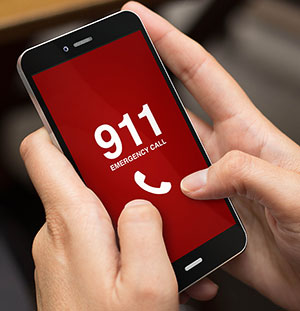
Fires Can Reach Dangerous Levels in Seconds
Any delay in getting emergency responders to the scene can result in additional loss of life and property. Having the necessary information ready will enable the emergency dispatcher to send the appropriate help quickly.
Do you have an emergency?
An emergency is any serious situation in which law enforcement, fire, or EMS is needed right away. If you are unsure of whether your situation is an emergency, call your park’s emergency number. The emergency dispatcher will determine if you need emergency assistance. Remember, although 911 works for more than 90% of the country, your park may have a different emergency number to call for the most effective emergency response. Know what it is.
Knowing your location is vital.
Never assume that the emergency dispatcher knows your location. Be prepared to describe where you are, inside or outside. Look for landmarks, street signs, building numbers, mile markers, and other reference points. Know the name of the town or area you are in. Indoors, know the floor and room.
Answer all of the dispatcher’s questions.
Stay calm, be patient, and answer all the questions the emergency dispatcher asks.
Do not hang up, even if you called by mistake.
Emergency dispatchers are trained to get the most important information as quickly as possible. They will let you know when it is OK to hang up. If you call by accident, stay on the line until you can tell the dispatcher that you called by accident and there is no emergency. This saves them from having to call you back and confirm there is no emergency or possibly send rangers with lights and sirens to check your address for an emergency.
Fire Info for You
Employees
Teach your children when and how to report an emergency. Practice with a pretend phone, and make sure they know how to call on all of the phones in the house.
Park Leadership
Ensure that park emergency contact information is kept current with park, local, and interagency dispatch centers. Identify how park employees should call for help in emergencies and make sure that the protocol is effectively communicated to them.
Park/National/Regional Leadership
Make sure the Serious Incident Notification protocol is properly used.
Take Action
- Depending on where you live and work, 911 is not always the number to call for an emergency. Identify what number you would need to call.
- Make a list of the essential information you would need to give an emergency dispatcher. Tape it to your phone.
- Practice: Pick one location today and practice describing your exact location as if you were talking to a dispatcher.
NPS Fire Facts
911 Facts
911 was first implemented in Haleyville, Alabama, on February 16, 1968. Today, over 270,000 calls to 911 are made each day in the United States. Up to 80% of those calls are non-emergencies.
Last updated: October 20, 2016
